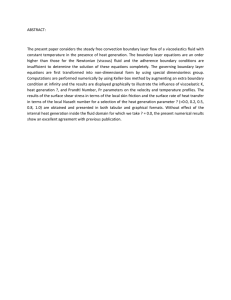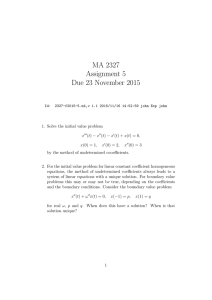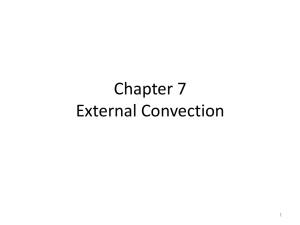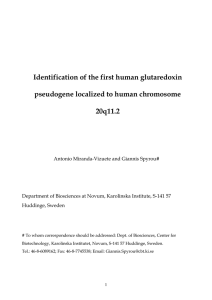FREE CONVECTION CHAPTER 7
advertisement
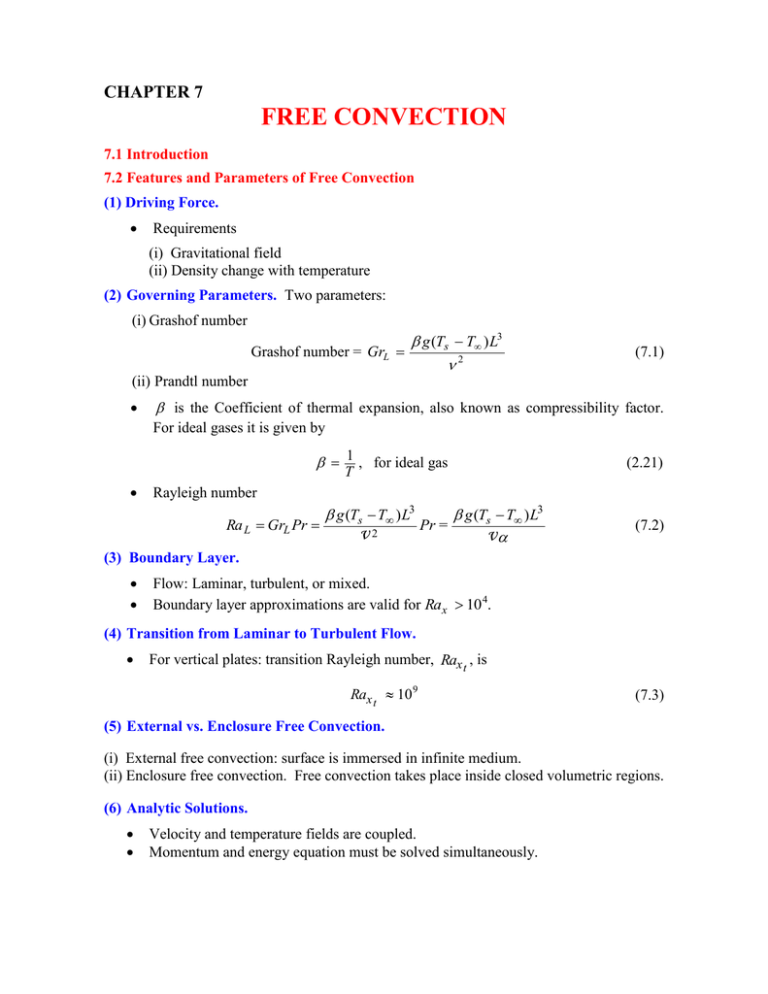
CHAPTER 7 FREE CONVECTION 7.1 Introduction 7.2 Features and Parameters of Free Convection (1) Driving Force. Requirements (i) Gravitational field (ii) Density change with temperature (2) Governing Parameters. Two parameters: (i) Grashof number g (Ts T ) L3 Grashof number = GrL 2 (7.1) (ii) Prandtl number is the Coefficient of thermal expansion, also known as compressibility factor. For ideal gases it is given by 1 , for ideal gas (2.21) T Rayleigh number Ra L GrL Pr g (Ts T ) L3 ν2 Pr = g (Ts T ) L3 ν (7.2) (3) Boundary Layer. Flow: Laminar, turbulent, or mixed. Boundary layer approximations are valid for Rax 10 4. (4) Transition from Laminar to Turbulent Flow. For vertical plates: transition Rayleigh number, Rax t , is Rax t 10 9 (7.3) (5) External vs. Enclosure Free Convection. (i) External free convection: surface is immersed in infinite medium. (ii) Enclosure free convection. Free convection takes place inside closed volumetric regions. (6) Analytic Solutions. Velocity and temperature fields are coupled. Momentum and energy equation must be solved simultaneously. 2 7.3 Governing Equations Approximations: (1) Constant density, except in evaluating gravity forces. (2) The Boussinesq approximation (relates density change to temperature change). (3) No dissipation. Continuity, momentum, and energy equations are obtained from equations (2.2), (2.29) and (2.19), respectively u u v 0 x y (7.4) u u 1 2u 2u v g (T T ) ( p p ) v ( 2 2 ) x y x x y (7.5) u v v 1 2v 2v v ( p p ) v ( 2 2 ) x y y x y (7.6) 2T 2T T T v 2 2 x y y x (7.7) u 7.3.1 Boundary Layer Equations Continuity equation (7.4) is unchanged x-component of the Navier-Stokes equations simplifies to u u u 2u v βg T T v 2 x y y (7.8) Energy equation (7.7) u T T 2T v α 2 x y y (7.4), (7.8), and (7.9) contain three unknowns: u, v, and T. Momentum and energy are coupled. (7.9) 7.4 Laminar Free Convection over a Vertical Plate: Uniform Surface Temperature Uniform temperature Ts (Fig. 7.1). Infinite fluid at temperature T . Determine: velocity and temperature distribution. 7.4.1 Assumptions. Note all assumptions listed in this section. 7.4.2 Governing Equations 3 u v 0 x y u (7.4) u u 2u v βg T T v 2 x y y (7.8) 2 v α 2 x y y (7.10) u where is defined as T T Ts T (7.11) 7.4.3 Boundary Conditions. Velocity: (1) (2) (3) (4) u ( x,0) 0 v( x,0) 0 u ( x, ) 0 u (0, y ) 0 Temperature: (5) ( x,0) 1 (6) ( x, ) 0 (7) (0, y ) 0 7.4.4 Similarity Transformation. Introduce the similarity variable 1/ 4 Gr x 4 y x (7.14) where Grx Let g (Ts T ) x 3 ν2 ( x, y ) ( ) u 2v (7.15) (7.16) Grx d x d (7.20) Continuity gives v v 1/ 4 (4) (Grx )1/ 4 x d d 3 (7.21) (7.20) and (7.21) into (7.8) and (7.10) and using (7.11) and (7.16), gives d 3 d 2 2 d 0 3 2 d 3 d 2 d (7.22) 4 d 2 d 2 3Pr d 0 d (7.23) Transformation of boundary conditions: Velocity: d (0) 0 d (2) (0) 0 d () (3) 0 d d () (4) 0 d (1) Temperature: (1) (0) 1 (2) () 0 (3) () 0 The problem is characterized by a single parameter which is the Prandtl number. 7.4.5 Solution. (7.22) and (7.23) and their five boundary conditions are solved numerically. The solution is presented graphically in Figs. 7.2 and 7.3. Fig. 7.2 gives the 5 7.4.6 Heat Transfer Coefficient and Nusselt Number. Fourier’s law and Newton’s law: T ( x,0) y Ts T k h Express in terms of and h (7.24) k dT d (0) Ts T d d y Use(7.11) and (7.14) k Grx h x 4 1/ 4 d (0) d (7.25) Local Nusselt number hx Gr Nu x x k 4 1/ 4 d (0) d (7.26) Average h 1 h L Table 7.1 [1,2] L h( x)dx (2.50) 0 (7.25) into (2.50), and performing the integration 1/ 4 4 k GrL h 3 L 4 d (0) d (7.27) Average Nusselt number is 1/ 4 Nu L hL 4 Gr L k 3 4 d (0) d (7.28) Solution depends on a single parameter which is the Prandtl number. d (0) Numerical solution gives , listed in Table 7.1. d Special Cases Very small and very large Prandtl numbers: Nu x 0.600 ( PrRa x )1/4 , Nu x 0.503 ( PrGrx )1/4 , Pr 0 Pr (7.29a) (7.29b) 7.5 Laminar Free Convection over a Vertical Plate: Uniform Surface Heat Flux Assumptions: Same as constant temperature plate. Pr _ d (0) d 2 (0) d 2 0.01 0.03 0.09 0.5 0.72 0.733 1.0 1.5 2.0 3.5 5.0 7.0 10 100 1000 0.0806 0.136 0.219 0.442 0.5045 0.508 0.5671 0.6515 0.7165 0.8558 0.954 1.0542 1.1649 2.191 3.9660 0.9862 d 0.676 0.6741 0.6421 0.5713 0.4192 0.2517 0.1450 6 Surface boundary conditions k T ( x,0) q s y (7.30) Surface flux is specified. Determine: Surface temperature Ts (x) and local Nusselt number Nu x . Solution by similarity transformation. Solution: Surface temperature ν 2 (qs ) 4 Ts ( x) T 5 x 4 g k (0) (7.31) Local Nusselt number g q Nu x 2 s x 4 5ν k 1/ 5 1/ 5 1 (0) (7.32) Table 7.2 [4] (0) is a dimensionless parameter which depends on the Prandtl number and is given in Table 7.2 [4]. Correlation equation for (0) 4 9 Pr 10 Pr 5Pr 2 (0) 1/ 2 10 1/ 5 , 0.001 Pr 1000 (7.33) Properties at the film temperature T f T f T Ts (L / 2) / 2 7.34) 7.6 Inclined Plates Vertical plate solutions of Sections 7.4 and 7.5 apply to inclined plates, with g replaced by g cos . This approach is recommended for 60 o . 7.7 Integral Method 7.7.1 Integral Formulation of Conservation of Momentum Pr 0.1 1.0 Assume: t (a) 100 (0 ) - 2.7507 - 1.3574 - 0.76746 - 0.46566 7 Application of the momentum theorem in the x-direction to the element dx , Fig. 7.6 Fx M x (out ) M x (in ) (b) dx is enlarged in Fig. 7.7 Mx dM x dx dx p d ( p )dx dx dy o dx dx M x dW gdxdy ( p dp / 2)d p Fig. 7.7 dM x dp d p p d p p dx o dx M x dx M x 2 dx dx (c) Simplify dp o dx dW Wall shearing stress o dM x dx dx (d) u x,0 y Weight of element (e) dW dx g dy (f) 0 The x-momentum of the fluid entering element ( x) Mx u 2 dy (g) 0 (e), (f) and (g) into (d) dp u x,0 y dx 0 d gdy dx u dy 2 (h) 0 Combine pressure and gravity terms dp dp g dx dx (i) 8 Multiply by and rewrite as integral dp g gdy dx (j) 0 (j) into (h) u x,0 g y d ( )dy u 2 dy dx 0 0 (k) Express density difference in terms of temperature change (T T ) (2.28) (2.28) into (k) ν u ( x,0) d g (T T ) dy u 2 dy y dx 0 0 (7.35) (7.35) applies to laminar as well as turbulent flow. 7.7.2 Integral Formulation of Conservation of Energy Assume: (1) (2) (3) (4) No changes in kinetic and potential energy Negligible axial conduction Negligible dissipation Properties are constant Forced convection formulation of conservation of energy, (5.7), is applicable to free convection T x,0 d y dx ( x) u (T T )dy (7.36) 0 7.7.3 Integral Solution Vertical plate, Fig. 7.6. Uniform surface temperature Ts . We assumed t . Thus we have two equations, (7.35) and (7.36) for the determination of a single unknown . Since both (7.35) and (7.36) must be satisfied, we introduce another unknown as follows: Assumed Velocity Profile: ux, y a0 ( x) a1 ( x) y a2 ( x) y 2 a3 ( x) y 3 Boundary conditions on the velocity (1) u ( x,0) 0 (2) u ( x, ) 0 (a) 9 (3) (4) u ( x, ) 0 y 2u ( x,0) y 2 g (Ts T ) Applying the four boundary conditions gives a n . Equation (a) becomes g (Ts T ) 2 y y u 1 4ν 2 (b) Let g (Ts T ) 2 u o ( x) 4ν (c) (b) becomes 2 y y u uo ( x) 1 Treat uo (x) as the second unknown function, independent of . (7.37) Assumed Temperature Profile: T ( x, y) b0 ( x) b1 ( x) y b2 ( x) y 2 (d) The boundary conditions are (1) T ( x,0) Ts (2) T ( x, ) T T ( x, ) (3) 0 y Application of the above boundary conditions gives y T ( x, y) T (Ts T ) 1 Heat Transfer Coefficient and Nusselt Number T ( x,0) y Ts T 2 (7.38) k h (7.24) (7.38) into (7.24) h 2k ( x) (7.39) hx x 2 k ( x) (7.40) Thus the local Nusselt number is Nu x Must find and uo (x) and (x). 10 Solution (7.37) and (7.38) into (7.35) ν uo g (Ts T ) 0 Evaluate the integrals 2 d uo y 1 dy dx 2 2 4 y y 2 1 dy 0 u 1 d 2 1 u o δ βg Ts T δ ν o 105 dx 3 δ (e) (7.41) (7.37) and (7.38) into (7.36) d uo 2 (Ts T ) (Ts T ) dx 1 ( x) 0 4 y y 1 dy (f) Evaluate the integrals 1 d uo 1 60 dx (7.42) (7.41) and (7.42) are two equation for (x ) and uo (x). Assume a solution of the form uo ( x) Ax m (7.43) ( x) Bx n (7.44) A, B, m and n are constants. substitute (7.43) and (7.44) into (7.41) and (7.42) 2m n 2 2 m n1 1 A A Bx g To T Bx n v x mn 105 3 B mn 1 ABx m n 1 x n 210 B 2m n 1 n m n (g) m n 1 n (h) Solve (g) and (h) for m and n gives 1 1 , n 4 2 (i) (i) into (7.45) and (7.46) gives A and B 20 A 5.17v Pr 21 and (7.46) Exponents in each equation must be identical. Thus m (7.45) 1 / 2 g (Ts T ) v2 1/ 2 (l) 11 1/ 4 20 B 3.93 Pr -1/2 Pr 21 g (Ts T ) v2 1 / 4 (m) (i) and (m) into (7.44) 20 1 3.93 1 x 21 Pr 1/ 4 ( Ra x ) 1/ 4 (7.47) (7.47) into (7.40) 20 1 Nu x 0.508 1 21 Pr 1/ 4 ( Ra x )1/ 4 (7.48) 7.7.4 Comparison with Exact Solution for Nusselt Number (7.26) is the exact solution to the local Nusselt number Gr Nu x x 4 Nu x d (0) d 1/ 4 20 1 Nu x 0.508 1 21 Pr 0.600 ( PrRa x )1/4 , Pr 0 exact (7.49) integral 0.514( PrRa x )1 / 4 , Pr 0 (7.51a) Exact and integral solutions for Pr are Pr (7.29b) 0.508( Ra x )1 / 4 , Pr (7.51b) 0.503 ( Ra x )1/4 , Nu x exact Nu x integral 1/ 4 (4 Pr )1/ 4 (7.50) Table 7.3 Pr _ d (0) 20 1 0.508 1 21 Pr 0.01 0.03 0.09 0.5 0.72 0.733 1.0 1.5 2.0 3.5 5.0 7.0 10 100 1000 0.0806 0.136 0.219 0.442 0.5045 0.508 0.5671 0.6515 0.7165 0.8558 0.954 1.0542 1.1649 2.191 3.9660 0.0725 0.1250 0.2133 0.213 0.4627 0.5361 0.5399 0.6078 0.7031 0.7751 0.9253 1.0285 1.1319 1.2488 2.2665 4.0390 d 1 / 4 (7.29a) Applying integral solution (7.47) to Pr 0 Nu x 1 / 4 The right hand side of (7.49) and (7.50) are compared in Table 7.3. The exact solution for Pr 0 Nu x (7.26) Rewrite (7.48) Grx 4 d (0) d Rewrite (7.26) as Grx 4 1/ 4 NOTE: The error ranges from 1% for Pr to 14% for Pr 0 . (4 Pr)1/4
